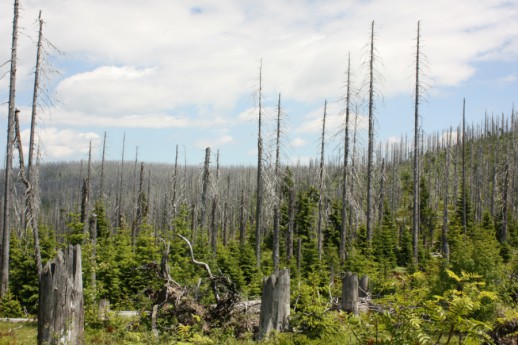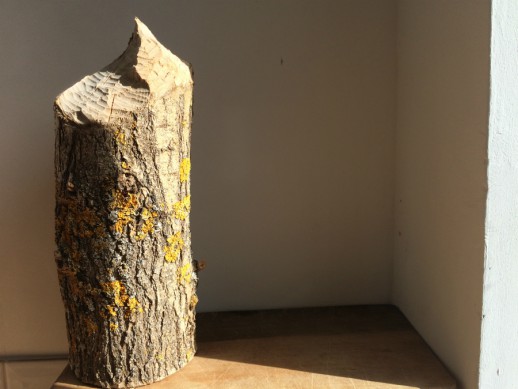By Katherine Price
On my windowsill is a piece of willow. Thirty centimetres long, ten centimetres in diameter, its grey fissured bark is splashed by lichen the colour of fresh egg yolks. At one end it is flat, where I cut it with a saw so that I could take it with me. At the other end it is beautifully worked. It dwindles to a point and the cone is multifaceted, like a pencil that has been sharpened with a penknife. Each angled plane is striped by lateral ridges as if it had been shaped with a gouge. Precise, purposeful.
When I show this wood to friends, they don’t know what to make of it. They would never have come across it in England. Or at least, not until now.
This willow was shaped by beavers. They’ve been back in Scotland for a few years and now a handful of them are back in England under licence. Drivers and pub landlords and gun owners and James Bond and people on parole operate under licence. It’s a quid pro quo kind of thing. A right to do specific things in return for sticking to rules. I wonder if the newly licensed rodent residents of South Devon know what they’ve been signed up to. For though we can just about accept that we haven’t a chance against asteroids and plate tectonics, we brook no disruption to our semi-sacred landscape from the lower orders, especially if they’re from ‘abroad’. So it was no surprise to read alarmist headlines in the Scottish press a couple of years ago: ‘Bavarian beavers wrecking fields and forests.’ The Tayside beavers were given temporary leave to remain while their effect on the landscape was studied, but next month Scottish ministers will have to decide whether the beavers stay or go when Scottish Natural Heritage submits a final report.
Beavers change landscapes – dramatically – but ‘wrecking’ is a subjective term. Ecologist Tom Wells writes brilliantly about these landscape architects in his 1997 book ‘Reading the forested landscape: a natural history of New England.’ Visiting beaver ponds near his home, he writes:
‘Standing on skis at midnight, alone under a January full moon, surrounded by large spruce and pine snags, my feeling of seclusion is as great as any I’ve ever experienced. Yet this is far from an untouched environment. It is a highly manipulated ecosystem, one that has been dramatically altered to suit the needs of a single species – the beaver. Beavers are the only animals, other than humans, that will create entirely new ecosystems for their own use. And often, like humans, once they have depleted an area’s resources, they will abandon their holdings and move on.’
By coincidence, I found my length of willow in Bavaria, where many people view the beaver with the same alarm voiced by the Scottish press. Four years ago, after a long absence, beavers returned to Bogen, a small town (pop 12,000) on the north bank of the Danube. We spotted their meadow from the two car train as it approached the end of the line at Bogen bahnhof: a couple of acres just outside the old town walls on the banks of the Kinsach, several hundred metres upstream from where it joined the Danube. Though it was August, it looked like winter in the beaver meadow. In the year since their return, the beavers had felled more than thirty trees, mostly willows less than a handspan in diameter. The gnawed stumps stood bleached, the bark-stripped leafless trunks lay haphazard. The animals had made muddy slipways and partially dammed the Kinsach. I borrowed a saw and slithered down the embankment to claim my prize.
Other people weren’t so excited. The beavers made the local people twitchy, the hunters’ trigger fingers itchy. It was too close for comfort and, unfortunately for the beavers, their landscaping echoed the disaster playing out on the other side of town.
Behind Bogen rises the Bavarian Forest, classic middle-European habitat, wave upon wave of low mountain cloaked by dark dense conifers. The dominant tree had for several years been suffering catastrophic collapse. Spruce, the tree central to Bogen’s fortunes for centuries, was dying by the million. In places the forest was a wasteland of silver grey skeletons as stark and shocking as the trees stripped bare by the beavers. Here though, the agent was the bark beetle. Its larvae finished off trees made vulnerable by a run of unusually hot summers.

Dead spruce in the Bavarian Forest, devasted by bark beetle larvae. pic Andreas Groeger
It was not the first time this had happened. In the 1470s, the forest was devastated by the bark beetle in the same way. The people prayed and the forest recovered. Even now, more than 500 years on, they give thanks each year in a ritual with nicely pagan overtones. A thirteeen metre spruce trunk is carried by a procession of townspeople to the church on the Bogenberg, a granite outcrop above the Danube. The forest will recover again. Where the spruce fails, other species will grow. In the meantime, the people were fretting and called for action. Inject the trees with insecticide. Propagate and plant more spruce. Irrigate in summer. In the twenty-first century, there should be no place for such natural disaster.
This year I was back in Bogen but the beavers were gone. Their meadow is once again a dense tangle of willow. It could be that they had exhausted their holdings and moved on, but it doesn’t look like it. It could be that they were hunted out.
This is a cautionary tale for our friends in South Devon and in the Tay. If the beaver is to stay we need to loosen up. We need to move beyond the ‘heritage landscape,’ the fetishised olde worlde, and carve out space for natural flux. Floods spill rich sediments onto the plain. Trees die where they stand and their deadwood supports insects, birds and fungi. Rock falls open up the forest for butterflies. The collapsing coastline forms new cliffs for nesting sandmartins. Aquatic plants colonise the pond behind the beaver dam. Fish follow.
Sometimes it’s hard to remember that change is not all invasive plants, loss of habitats, extinctions, sudden oak death. Change is intrinsic to nature’s resilience, opportunism, relentlessness. For the beaver to stand a chance, a good story needs to be told; relandscaping rather than ‘wrecking’, diversifying rather than destroying. These animals can help us reconnect with the processes and the cycles of the natural world, the ones that take more than a season or a year and whose outcomes we cannot predict, still less control. And, if we allow them to, maybe in a few years when I press this heavy bit of wood into the arms of a visiting child, they’ll recognise it immediately and weigh it with awe.
Katherine worked as a gardener at Royal Botanic Gardens, Kew for ten years and now leads the comms team at SOAS. She wrote the ‘Kew Guide’ (2014). Agent Richford Becklow is trying to find a publisher for her first novel, ‘The Greening of Louise Long’.
